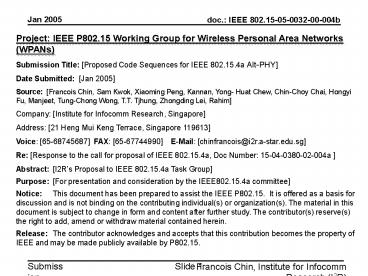IEEE 802'15 PHY Proposal - PowerPoint PPT Presentation
Title:
IEEE 802'15 PHY Proposal
Description:
Voice: [65-68745687] FAX: [65-67744990] E-Mail: [chinfrancois_at_i2r.a-star.edu.sg] ... The same base sequence will be used to construct the symbol-to-chip mapping table ... – PowerPoint PPT presentation
Number of Views:39
Avg rating:3.0/5.0
Title: IEEE 802'15 PHY Proposal
1
Project IEEE P802.15 Working Group for Wireless
Personal Area Networks (WPANs) Submission Title
Proposed Code Sequences for IEEE 802.15.4a
Alt-PHY Date Submitted Jan 2005 Source
Francois Chin, Sam Kwok, Xiaoming Peng, Kannan,
Yong- Huat Chew, Chin-Choy Chai, Hongyi Fu,
Manjeet, Tung-Chong Wong, T.T. Tjhung, Zhongding
Lei, Rahim Company Institute for Infocomm
Research, Singapore Address 21 Heng Mui Keng
Terrace, Singapore 119613 Voice 65-68745687
FAX 65-67744990 E-Mail chinfrancois_at_i2r.a-
star.edu.sg Re Response to the call for
proposal of IEEE 802.15.4a, Doc Number
15-04-0380-02-004a Abstract I2Rs Proposal to
IEEE 802.15.4a Task Group Purpose For
presentation and consideration by the
IEEE802.15.4a committee Notice This document
has been prepared to assist the IEEE P802.15. It
is offered as a basis for discussion and is not
binding on the contributing individual(s) or
organization(s). The material in this document is
subject to change in form and content after
further study. The contributor(s) reserve(s) the
right to add, amend or withdraw material
contained herein. Release The contributor
acknowledges and accepts that this contribution
becomes the property of IEEE and may be made
publicly available by P802.15.
2
Proposed Code Sequences, Modulation Coding
for IEEE 802.15.4a Alt-PHY
- Francois Chin
- Institute for Infocomm Research
- Singapore
3
Proposal Motivation
- To satisfy IEEE 802.15.4a technical requirements,
low power consumption is crucial - Conventional coherent UWB system based on
correlator in the receiver can provide fairly
good performance, but at the expense of
implementation complexity, and consequently power
consumption and system cost - To meet low power and low cost requirement, UWB
system with OOK (On-Off Keying) modulation and
noncoherent detection is proposed - In the proposed UWB OOK system, the signal
demodulation is performed by simply integrating
signal energy, thus omitting signal / pulse
generator, significantly relieve the strict
synchronization requirement and greatly simplify
transceiver structure with the minimal power and
cost demand - However, some challenges of such OOK system are
threshold setting, simultaneous operating
piconets (SOP) timing boundaries estimation - This proposal contains techniques that will
overcome such limitation, and improve the overall
system performance of the UWB OOK system
4
Proposed System Parameters
Proposed chip rate of 11 MHz is a common
denominator in the clock rate of 11a/b/g, MB-OFDM
and DS-UWB
5
UWB Pulse Spectrum
- 1.5 ns rectified cosine shape
- 1400 MHz 10-dB bandwidth
- Centre frequency 4 GHz
6
Modulation Coding
Binary data From PPDU
Scrambling 1,-1 Sequence
0,1 Sequence
Bit-to- Symbol
Chip Repetition
Symbol- to-Chip
Pulse Generator
Chip Scrambler
0,1,-1 Sequence
- Bit to symbol mapping
- group every 4 bits into a symbol
- Symbol-to-chip mapping
- Each symbol is mapped to a 32-chip 0,1
sequence, according to Gray Coded Code Position
Modulation (CPM) - Chip Repetition (11 Mcps)
- Factor of K5 corresponds to 275 kbps (Mandatory
Mode) - Chip Scrambling (11 Mcps)
- the K x 32-chip 0,1 sequence is mutliplied
with random scrambing 1,-1 sequence - this is to avoid spectral spikes
- Pulse Generator (11 x 12 132 MHz)
- Chips are repetited and Ternary -modulated
- chip 1' ? 12 ve pulse are transmitted _at_
132 MHz - chip -1' ? 12 -ve pulse are transmitted _at_
132 MHz - chip '0' ? no pulse
7
Multiple access
- Multiple access within piconet same as 15.4.
- Multiple access across piconets CDMA.
- Different Piconet uses different Base Sequence
8
Base Sequence Set
- 31-chip M-Sequence set
- Only one sequence and one fixed band (no hopping)
will be used by all devices in a piconet - Logical channels for support of multiple piconets
- 6 sequences 6 logical channels (e.g.
overlapping piconets) - The same base sequence will be used to construct
the symbol-to-chip mapping table
9
Symbol-to-Chip Mapping Gray Coded Code Position
Modulation (CPM)
To obtain 32-chip per symbol, cyclic shift the
Base Sequence first, then extend 1-chip
Base Sequence 1
10
Properties of M-Sequences
- Cyclic auto-correlation of any antipodal sequence
gives peak value of 31 and sidelobe value of -1
throughout - Cyclic correlation of any antipodal sequence with
its corresponding uni-podal sequence give peak
value of 16 and correlation with other 15
uni-podal sequences with give zero sidelobe
throughout - i.e. Each transmit OOK sequence will give a peak
correlator output at a correlator with its
corresponding antipodal sequence ZERO at other
15 correlators
11
Cyclic Extended Chip
- To avoid / reduce inter-symbol interference in
channels with excess delay spread - To ensure zero inter-chip interference in
receiver correlator output
12
Synchronisation Preamble
Correlator output for synchronisation
- Code sequences has excellent autocorrelation
properties - Preamble is constructed by repeating Sequence
0000
13
The transmitter
- Guide Line Keep it Simple
- Main Goal "Low cost low consumption"
- Pulses are generated in baseband
- No mixer, no VCO but pulse shaping
- Simple control logic and "reasonable" clock
frequency (Crystal)
PSDU Data
Clock F 132MHz
Control Logic
BaseBand signal
Pulse shaper
PA (option)
Pulse Generator
RF Signal
14
The receiver
Fc5.5MHz
Soft Despread
BPF
( )2
LPF
ADC
- Energy detection technique rather than coherent
receiver, for relaxed synchronization constraints - Soft chip values gives best results
- Oversampling sequence correlation is used to
recovery chip timing recovery - Synchronization fully re-acquired for each new
packet received (gt no very accurate timebase
needed) - Low cost, low complexity
22 MHz Sample Rate
15
Frame Format
2
1
0/4/8
2
n
Octets
Data Payload
Frame Cont.
MAC Sublayer
Seq.
Address
CRC
MHR
MSDU
MFR
Data 32 (n23)
TBD
1
1
For ACK 5 (n0)
Octets
PHY Layer
Frame Length
Preamble
SFD
MPDU
SHR
PHR
PSDU
PPDU

